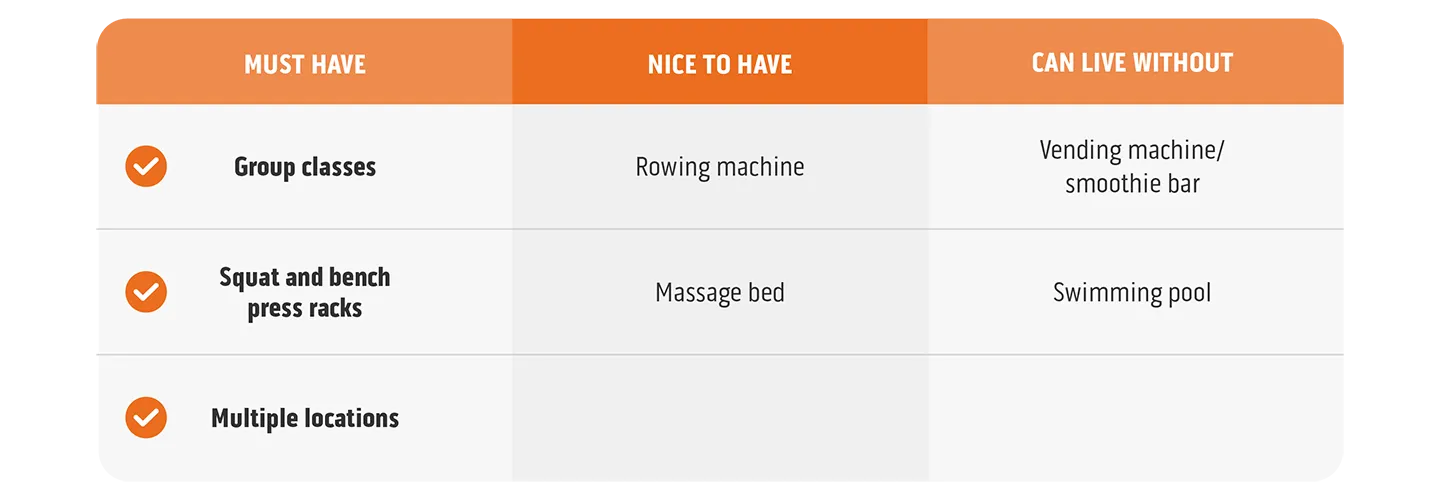Exercise More
This resolution is the reason it may be a struggle to find a parking spot at gyms, yoga studios, and body pump classes in January. And for good reason – exercising is an important step in both physical and mental health.
So how can you plan for it in your budget?
First, you’ll need to determine what type of exercise you want to start or increase. Want to lift weights? Take classes? Hop on a treadmill? Or even just walk more? Each of these choices will have slightly different budgeting plans.
If you plan on joining a gym, yoga or dance studio, or any other type of fitness center, do your research. Look for gyms nearest to your home or your work. Take a tour and make sure it offers the equipment, classes, and amenities you’re looking for.
Consider which options are absolute must-haves, what are nice-to-haves, and which you can live without. For example…

Additionally, remember some gyms require a contract, and some charge more if you plan on taking classes. Some may only have one location, and others have locations all over the country. Think about which options are going to be right for you.
Then, once you’ve narrowed your choices down, be sure to compare pricing to find out which offers the right mix of amenities and cost.
If you plan on completing workouts at home, you may still have some items to budget for. Look into pricing for any equipment you may need to buy, such as dumbbells, stationary bikes, kettle bells, or yoga mats. Pricing for home-gym equipment has increased recently, so you may want to try searching re-sale options for better pricing, though you can also look for bodyweight programs that don’t require much (if any) equipment. You may also want to purchase workout guides, but you can also search Google and YouTube for free programs and classes.
Another option for exercising more is to start walking or running. While many think this is the most inexpensive option, the cost of running gear can add up. You’ll want to consider going to a running store where you can get fitted for shoes specifically for your foot shape and walking/running gait. The shoes you may get here are likely to be more expensive, but will provide more support, last longer (meaning you have to purchase shoes less frequently), and cause fewer injuries than buying cheaper shoes, especially as you pack on the miles.
If you need to add on to your fitness-related attire, again consider looking for options at re-sale stores for inexpensive options.
Once you’ve made your decisions, be sure to budget for them. Include gym memberships in any budgeting resources you use as a fixed, regular expense. If you want to eventually upgrade your home equipment or workout gear, determine how much money you’ll need to make your purchase(s) and create a plan to set a small amount aside each month in a savings account to prepare for the purchase.
Want help with creating your budget? Try this budgeting tool.
Eat Better
You may think that eating better is going to cost significantly more, but that’s not necessarily true.
Start by creating a meal plan. Determine what your menu is for the week. Look for simple, healthy recipes that contain plenty of protein and vegetables. Then, create your grocery list.
Ideally, your grocery shopping should consist primarily of the outside walls of the store rather than the aisles, which tend to include more processed foods, which not only are less healthy than whole foods, but also more expensive. Don’t believe me? Next time you’re at the grocery store, check out the cost of a block of cheese vs. the cost of the same volume of shredded cheese.
Also, don’t be afraid to buy generic. Generic options are typically just as good (and tasty!) as name brands, but with a much better price point.
And once you have your grocery list, stick to it. Don’t go to the store hungry if you can avoid it, as hungry shopping often causes impulsive, less-healthy purchases, and ultimately, a higher grocery bill.
Another way to save money while eating healthy is to eat more of your meals at home. Restaurants may make delicious food, but even salads can be less healthy than you’d think depending on their toppings and dressings. Not to mention – it’s much more expensive to eat out than to cook a meal at home.
You can also cut down on spending by cooking larger meals and saving a few servings for leftovers, which also helps cut down on money you spend on meals at restaurants.
And don’t be afraid to pick up a new hobby – gardening! When you grow your own vegetables, they often taste fresher, and cost much less.
Travel More
Who doesn’t want to see more of the country and the world? If that’s in your plan for the coming year, know there are ways to do it without blowing your entire paycheck and racking up debt.
First, create your travel plan. Where do you plan to go? Consider visiting during an “off-season” for the area for a less expensive trip. For example, tropical locations often are higher-trafficked and more expensive during cold weather months, so think about scheduling a trip during warmer months when costs may be lower.
Think about your actual travel plan as well – are you driving, flying, taking a bus, riding a train? Whichever you choose, put travel expenses in your budget, including ticket prices, gas, rental cars, and more.
In addition, you’ll want to look into costs for hotels, apartment or home rentals (think Airbnb and Vrbo), or hostels. Perhaps even better? Visiting a friend and family member who may have a spare room for you to stay in!
Don’t forget to budget for expenses during the trip as well. By staying somewhere with a kitchen, for example, you can cut back on restaurant expenses by making meals at your home for the trip.
Once you have your budget set, determine how much time you have to save up before you hit the road. Divide the dollar amount of the trip by the number of months before you leave and set aside that amount every month in a savings account so you can cover the cost of your trip without adding to your debt.
Quit Smoking
Smoking is an expensive habit. Budgeting for it might seem silly, since giving it up means spending less on cigarettes.
However, you may want to budget for support in your journey. Look into the cost of nicotine patches, medication, counseling, or any other resources you may use to help you quit and include that in your budget for the new year.
Read More
Reading may seem like an inexpensive hobby, but not if you’re buying more and more new books. Get a library card to borrow books for our favorite price – free!
You’ll have the option to head to your local library to pick out a physical copy of your book to borrow. If they don’t have it, they may be able to get it for you from another library.
You can also download the Libby app and borrow e-books and audiobooks straight to your device!
Save Money
I mean, we’re a bank, so we had to talk about this one, right?
Lucky for you, we have a whole blog on exactly this topic. Check it out here!



